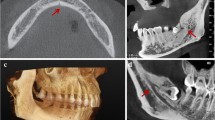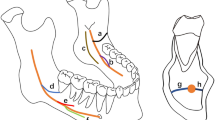Abstract
Purpose
This study aimed at identifying the course of the mandibular canal, the presence of anterior loop and accessory mental foramen, as well as verifying the association between these variables through the analysis of cone beam computed tomography (CBCT) exams.
Methods
CBCT images were analyzed to identify the type of mandibular canal path, classified into three types: (I) catenary; (II) progressive descending; and (III) straight. In addition, the presence of anterior loop and accessory mental foramen was analyzed. The variables were summarized by measures of absolute frequency, relative, mean and standard deviation. The Chi square and Fisher’s exact tests were used in the comparative analysis of the frequency distribution. The level of significance was 5%.
Results
The most frequent mandibular canal course was straight type (74.4%), followed by catenary (19.4%) and finally the progressive descending (6.2%). It was observed a prevalence of 10.2% for anterior loop and 7.9% for accessory mental foramen. There was no association between the presence of anterior loop (P = 0.798) and accessory mental foramen (P 0.480) with the mandibular canal course pattern, as well as no association between the anterior loop and the presence of the accessory mental foramen (P = 0.407).
Conclusions
The CBCT analysis is the best methodology for the investigation and localization of mandibular anatomical variations, which provides a good image quality of the bone tissue and details of the anatomical structures, reducing the risk of injury to the lower alveolar vascular-nervous bundle and, consequently, cause paralysis and hemorrhage in the anterior region of the mandible and adjacent structures.
Similar content being viewed by others
References
Al-Khateeb T, Hamasha AA, Ababneh KT (2007) Position of the mental foramen in an northeast regional Jordanian population. Surg Radiol Anat 29:231–237. https://doi.org/10.1007/s00276-007-0199z
Almeida KCM, Raveli TB, Vieira CIV, Santos-Pinto A, Raveli DB (2017) Influence of the cranial base flexion on Class I, II and III malloclusions: a systematic review. Dental Press J Orthod 22:56–66. https://doi.org/10.1590/2177-6709.22.5.056-066.oar
Andrade YDN, Araujo EBJ, Souza LMA, Groppo FC (2015) Análise das variações anatômicas do canal da mandíbula encontradas em radiografias panorâmicas. Rev Odontol UNESP 44:31–36. https://doi.org/10.1590/1807-2577.977
Apostolakis D, Brown JE (2012) The anterior loop of the inferior alveolar nerve: prevalence, measurement of its length and a recommendation for interforaminal implant installation based on cone beam CT imaging. Clin Oral Implants Res 23:1022–1030
Capote TSD, Gonçalves MA, Campos JADB (2015) Retromolar canal associated with age, side, sex, bifid mandibular canal and accessory mental foramen in panoramic radiographs of brazilians. Anat Res Int. https://doi.org/10.1155/2015/434083
de Oliveira-Santos C, Souza PH, de Azambuja Berti-Couto S, Stinkens L, Moyaert K, Rubira-Bullen IR et al (2012) Assessment of variations of the mandibular canal through cone beam computed tomography. Clin Oral Investig 16:387–393
Donovan J (2018) Is cone-beam computed tomography an essential diagnostic tool for endodontic practice? J Dent Health Oral Disord Ther 9:00322. https://doi.org/10.15406/jdhodt.2018.09.00322
Filo K, Schneider T, Locher MC, Kruse AL, Lübbers H (2014) The inferior alveolar nerve’s loop at the mental foramen and its implications for surgery. J Am Dent Assoc 145:260–269
Freitas GB, Silva AF, Morais LA, Silva MBF, Manhães LRC (2016) Classification and prevalence of changes mandibular canal through examination of cone-beam computed tomography. BJOMS 16:6–12
Fu E et al (2014) Bifid mandibular canals and the factors associated with their presence: a medical CT evaluation in a Taiwanese population. Clin Oral Implants Res 25:e64–e67
Haas LF et al (2016) Anatomical variations of mandibular canal detected by panoramic radiography and CT: a systematic review and meta-analysis. Dentomaxillofac Radiol 45:20150310
Imada TS, Fernandes LM, Centurion BS, de Oliveira-Santos C, Honório HM, Rubira-Bullen IR (2014) Accessory mental foramina: prevalence, position and diameter assessed by cone-beam computed tomography and digital panoramic radiographs. Clin Oral Implants Res 25:e94–e99
Iwanaga J et al (2015) The clinical anatomy of accessory mental nerves and foramina. Clin Anat 28:848–856
Jung YH, Cho BH (2014) Radiographic evaluation of the course and visibility of the mandibular canal. Imaging Sci Dent 44:273–278. https://doi.org/10.5624/jsd.2014.44.4.2731
Katakami K et al (2008) Characteristics of accessory mental foramina observed on limited cone-beam computed tomography images. J Endod 34:1441–1445
Kwon KH, Sim KB, Lee JM (2012) Evaluation of the course of the inferior alveolar canal in the mandibular ramus using cone beam computed tomography. J Korean Assoc Oral Maxillofac Surg 38:231–239. https://doi.org/10.5125/jkaoms.20012.38.4.231
Leite GMF et al (2014) Anatomic variations and lesions of the mandibular canal detected by cone beam computed tomography. Surg Radiol Anat 36:795–804. https://doi.org/10.1007/s00276-1247-5
Liu T, Xia B, Gu Z (2009) Inferior alveolar canal course: a radiographic study. Clin Oral Implants Res 20:1212–1218
Mangla R, Singh N, Dua V, Padmanabhan P, Khanna M (2011) Evaluation of mandibular morphology in different facial types. Contemp Clin Dent 2:200–206. https://doi.org/10.4103/0976-237X.86458
Mirbeigi S, Kazemipoor M, Khojastepour L (2016) Evaluation of the course of the inferior alveolar canal: the first CBCT study in an iranian population. Pol J Radiol 81:338–341. https://doi.org/10.12659/JR.896229
Naitoh M, Hiraiwa Y, Aimiya H, Gotoh K, Ariji E (2009) Accessory mental foramen assessment using cone-beam computed tomography. Oral Surg Oral Med Oral Pathol Oral Radiol Endod 107:289–294. https://doi.org/10.1016/j.tripleo.2008.09.010
Naitoh M, Yoshida K, Nakahara K, Gotoh K, Ariji E (2011) Demonstration of the accessory mental foramen using rotational panoramic radiography compared with cone-beam computed tomography. Clin Oral Iimplants Res 22:1415–1419
Nascimento EHL et al (2016) Assessment of the anterior loop of the mandibular canal: a study using cone-beam computed tomography. Imaging Sci Dent 46:69–75
Neves FS, Torres MGG, Oliveira C, Campos PSF, Crusoé-Rebello I (2010) Lingual accessory mental foramen: a report of an extremely rare anatomical variation. J Oral Sci 52:501–503
Neves FS et al (2014) Comparative analysis of mandibular anatomical variations between panoramic radiography and cone beam CT. Oral Maxillofac Surg 18:419–424
Rosa MB, Sotto-Maior BS, Machado VdeC, Francischone CE (2013) Retrospective study of the anterior loop of the inferior alveolar nerve and the incisive canal using cone beam computed tomography. Int J Oral Maxillofac Implants 28:388–392
Sisman Y, Sahman H, Sekerci AE, Tokmak TT, Aksu Y, Mavili E (2012) Detection and characterization of the mandibular accessory buccal foramen using CT. Dentomaxillofac Radiol 41:558–563. https://doi.org/10.1259/dmfr/63250313
Torres MGG, Valverde LF, Vidal MTA, Crusoé-Rebello IM (2015) Accessory mental foramen: a rare anatomical variation detected by cone-beam computed tomography. Imaging Sci Dent 45:61–65. https://doi.org/10.5624/jsd.2015.45.1.61
Worthington F (2004) Injury to the inferior alveolar nerve during implant placement: a formula for protection of the patient and clinician. Int J Oral Maxillofac Implants 19:731–734
Zmystowska-Polakowska E et al (2017) The assessment of accessory mental foramen in a selected polish population: a CBCT study. BMC Med Image 17:2–5. https://doi.org/10.1186/s12880-017-0188-6
Author information
Authors and Affiliations
Contributions
CL Vieira: project development, data collection, data analysis, manuscript writing; SAR Veloso: project development, data analysis; FF Lopes: data analysis, manuscript writing.
Corresponding author
Ethics declarations
Conflict of interest
The authors declare the absence of any conflict of interest.
Rights and permissions
About this article
Cite this article
Vieira, C.L., Veloso, S.d. & Lopes, F.F. Location of the course of the mandibular canal, anterior loop and accessory mental foramen through cone-beam computed tomography. Surg Radiol Anat 40, 1411–1417 (2018). https://doi.org/10.1007/s00276-018-2081-6
Received:
Accepted:
Published:
Issue Date:
DOI: https://doi.org/10.1007/s00276-018-2081-6






